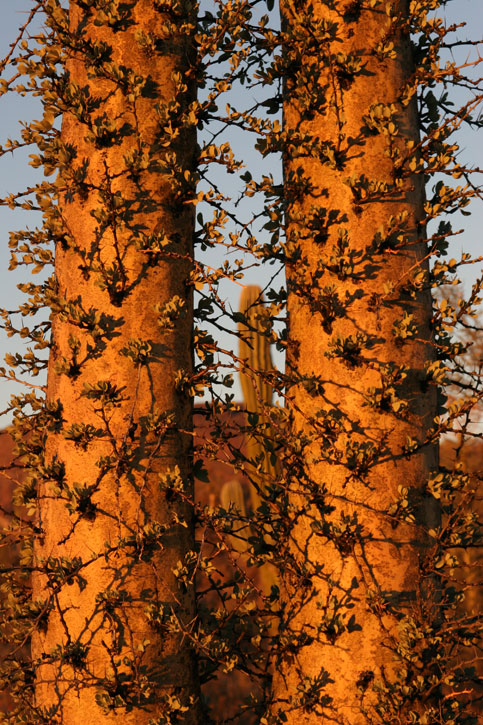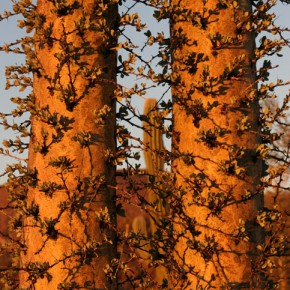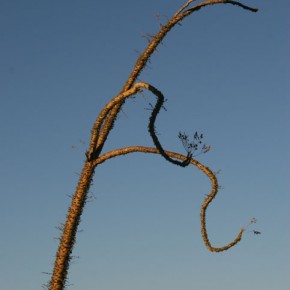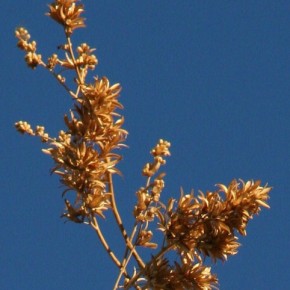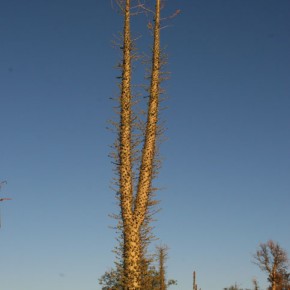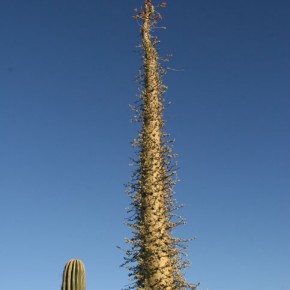Boojum trees are one of many reasons for tourists to visit the eight-hundred mile long peninsula below California, site of Mexico’s two most western states.
The Boojum (Fouquieria columnaris) was named in 1922 by a botanical explorer from Tucson, Godfrey Sykes, who adopted the name from a Lewis Carroll’s fictional character in The Hunting of the Snark. The genus Fouquieria is named after a French medical professor, P. E. Fouquier, and includes related stem succulents like the Ocotillo. The species name, columnaris, refers to the column-like structure of the Boojum.
The Boojum is endemic to Mexico, found primarily along the Baja peninsula, and a small section on the western side of the mainland. The plants forest the rocky hills and plains, growing as high as fifty feet or more, with a base diameter up to eighteen inches. The Boojums start as a single stem, looking much like an inverted carrot, and usually split into two or more stems as they mature. These split trees often take on strange and twisted shapes, sometimes arcing back to the ground, presenting irresistible subjects for the photographer.
The trees can live up to 300 years, and the gray-white stems leaf out with green, rounded leaves after rain. In late summer the trees produce a yellow flower cluster at the tip of the stems. The Mexican name for the Boojum, Cirio, comes from the candle-like appearance of the flowering tree.
Where to Find Mexico’s Boojum Trees
The extensive Boojum forests in Baja begin along Highway 1, just south of El Rosario de Arriba, about 220 miles south of Tijuana. In the northern part of their range, the Boojums are found mixed with Cardon cactus, a blend that gradually shifts to Boojums and Elephant trees as one travels farther south. The forests fade by the time you reach the border of Baja California Sur, about 230 miles south of where they first appear, although some trees continue to be found around Highway 1 as it continues southeast across the peninsula to the volcano Tres Virgenes.
Boojums also are found on the island Angel de la Guarda, which lies in the Sea of Cortez offshore and north of the Bahia de Los Angeles. A much smaller population of Boojums also grow in the Sierra Bacha, on the mainland directly across the Sea of Cortez from Isla Angel de la Guarda. Mexico’s Baja California Peninsula.
The Baja California peninsula stretches for 800 miles below the U.S. state of California, and ranges from 30 to 150 miles wide. Long a favored destination for adventure-oriented tourists, the peninsula consists of desert, mountains and a 3,000 mile coastline. Baja California is bordered on the west by the Pacific Ocean and on the east by the Sea of Cortez. The Mexican state of Baja California roughly covers the northern half of the peninsula, and the state of Baja California Sur covers the southern half.
Although generally pictured as a desolate and barren desert, the two states of Baja in fact represent a widely varied landscape with many tourist attractions including fishing, snorkeling and scuba diving, sailing and kayaking, whale watching and wine tasting.
The northeast corner of Baja resembles California’s Napa valley, with rolling hills, miles of vineyards, Olive trees and wineries. From Ensenada, mountains dominate the landscape for hundreds of miles to the border with the southern state. Far from barren, these mountains are carpeted like a botanical garden with hundreds of plant species. One of the strangest of these is the Boojum tree.
For those curious about the plant but unable to travel to Baja, several specimen trees can be found at the Arizona Sonora Desert Museum in Tucson, Arizona, as well as at the Boyce Thompson Arboretum east of Phoenix.
- Like Ocotillo, Boojums Leaf out after Rain. Photo by Bob Bowers.
- A Twisted Boojum. Photo by Bob Bowers.
- Blooms of the Cirio, or Boojum. Photo by Bob Bowers.
- Boojums Commonly Split into Twins. Photo by Bob Bowers.
- Boojums look like inverted carrots. Photo by Bob Bowers.

